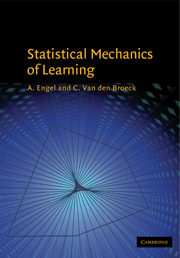Book contents
- Frontmatter
- Contents
- Preface
- 1 Getting Started
- 2 Perceptron Learning – Basics
- 3 A Choice of Learning Rules
- 4 Augmented Statistical Mechanics Formulation
- 5 Noisy Teachers
- 6 The Storage Problem
- 7 Discontinuous Learning
- 8 Unsupervised Learning
- 9 On-line Learning
- 10 Making Contact with Statistics
- 11 A Bird's Eye View: Multifractals
- 12 Multilayer Networks
- 13 On-line Learning in Multilayer Networks
- 14 What Else?
- Appendices
- Bibliography
- Index
Preface
Published online by Cambridge University Press: 05 June 2012
- Frontmatter
- Contents
- Preface
- 1 Getting Started
- 2 Perceptron Learning – Basics
- 3 A Choice of Learning Rules
- 4 Augmented Statistical Mechanics Formulation
- 5 Noisy Teachers
- 6 The Storage Problem
- 7 Discontinuous Learning
- 8 Unsupervised Learning
- 9 On-line Learning
- 10 Making Contact with Statistics
- 11 A Bird's Eye View: Multifractals
- 12 Multilayer Networks
- 13 On-line Learning in Multilayer Networks
- 14 What Else?
- Appendices
- Bibliography
- Index
Summary
Understanding intelligent behaviour has always been fascinating to both laymen and scientists. The question has become very topical through the concurrence of a number of different issues. First, there is a growing awareness of the computational limits of serial computers, while parallel computation is gaining ground, both technically and conceptually. Second, several new non-invasive scanning techniques allow the human brain to be studied from its collective behaviour down to the activity of single neurons. Third, the increased automatization of our society leads to an increased need for algorithms that control complex machines performing complex tasks. Finally, conceptual advances in physics, such as scaling, fractals, bifurcation theory and chaos, have widened its horizon and stimulate the modelling and study of complex non-linear systems. At the crossroads of these developments, artificial neural networks have something to offer to each of them.
The observation that these networks can learn from examples and are able to discern an underlying rule has spurred a decade of intense theoretical activity in the statistical mechanics community on the subject. Indeed, the ability to infer a rule from a set of examples is widely regarded as a sign of intelligence. Without embarking on a thorny discussion about the nature or definition of intelligence, we just note that quite a few of the problems posed in standard IQ tests are exactly of this nature: given a sequence of objects (letters, pictures, …) one is asked to continue the sequence “meaningfully”, which requires one to decipher the underlying rule.
- Type
- Chapter
- Information
- Statistical Mechanics of Learning , pp. ix - xiiPublisher: Cambridge University PressPrint publication year: 2001



